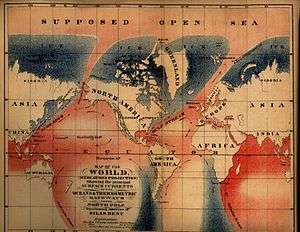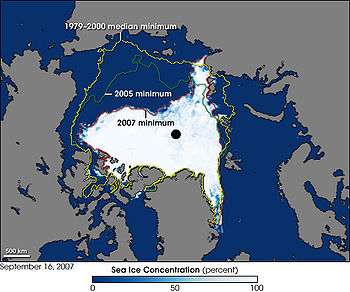Open Polar Sea
The Open Polar Sea was a hypothesized ice-free ocean surrounding the North Pole. This unproven (and eventually disproved) theory was once so widely believed that many exploring expeditions used it as justification for attempts to reach the North Pole by sea, or to find a navigable sea route between Europe and the Pacific across the North Pole.

History
The theory that the north polar region might be a practical sea route goes back to at least the 16th century when it was suggested by Robert Thorne. Explorers William Barents and Henry Hudson also believed in the Open Polar Sea. For a time, the theory was put aside due to the practical experience of navigators who encountered impenetrable ice as they went north. But the idea was revived again in the mid-19th century by theoretical geographers such as Matthew F. Maury and August Petermann. At this time, interest in polar exploration was high due to the search for John Franklin's missing expedition, and many would-be polar explorers took up the theory, including Elisha Kent Kane, Dr. Isaac Israel Hayes, and George Washington De Long. It was believed that once a ship broke through the regions of thick ice that had stopped previous explorers, a temperate sea would be found beyond it.
Arguments for the theory
Although today we know that the North Pole was covered with thick ice for much of the period, the theory of the Open Polar Sea was popular in the 16th–19th centuries and many arguments were made to justify its existence:
- Since sea ice only forms in proximity to land (now known to be a false theory itself), if there were no land near the North Pole, there would be no ice.
- Since there is perpetual sun during the Arctic summer, it would melt all the ice.
- Russian explorers found large areas of open water north of Spitzbergen, so surely there were other areas of open water elsewhere.
- Maury, Petermann, and other scientists who studied ocean currents in the 19th century hypothesized that warm northward currents such as the Gulf Stream and Kuroshio Current must rise to the surface and result in an ice-free sea near the pole.
- Extrapolation of temperature readings taken in subpolar regions indicated that the region of greatest cold would be at about 80° north instead of at the pole.
- Migration patterns of certain animals seemed to suggest that the polar region was a hospitable place for them to live.
Disproof and re-emergence

The Open Polar Sea theory was debunked gradually by the failure of the expeditions in the 1810s through the 1880s to navigate the polar sea. Reports of open water by earlier explorers, such as Elisha Kent Kane and Isaac Israel Hayes, fueled optimism in the theory in the 1850s and 1860s. Support faded when George W. De Long sailed USS Jeannette into the Bering Strait hoping to find an open 'gateway' to the North Pole and was met by a sea of ice. After a long drift, pack ice crushed the Jeannette and her survivors returned home with first hand accounts of an ice-covered polar sea. Other explorers such as British explorer George Nares confirmed this. By the time Fridtjof Nansen and Otto Sverdrup drifted through the polar ice pack in Fram in 1893–1895, the Open Polar Sea theory was defunct.
Nevertheless, scientific studies of climate change in the 2000s project that by the end of the 21st century, the annual summer withdrawal of the polar ice cap could expose large areas of the Arctic Ocean as open water, and an ice-free Arctic is possible in the future due to Arctic shrinkage. Although the North Pole itself could potentially remain ice-covered in winter, a navigable seasonal sea passage from Europe to the Pacific could develop along the north coast of Asia.
See also
- Northwest Passage
- Superseded scientific theories
References
Bibliography
- Potter, R. (2004). "The Open Polar Sea". Encyclopedia of the Arctic. Routledge.
- Robinson, M. (2006). The Coldest Crucible: Arctic Exploration and American Culture. Chicago.
- Robinson, M. (2006). "Reconsidering the Theory of the Open Polar Sea". Extremes: Oceanography's Adventures at the Poles.
- Sides, H. (2014). In the Kingdom of Ice: The Grand and Terrible Polar Voyage of the U.S.S. Jeannette. New York: Doubleday.
- Wright, J. K. (1966). The Open Polar Sea, Human Nature in Geography. Cambridge.